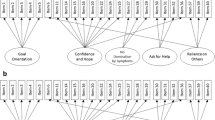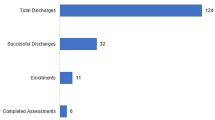Abstract
This is a 10 year longitudinal study of recovery progress within a residential program based upon therapeutic community principles and a Seven Domains Enhanced Recovery Model (Young and Ensing, 1999). A broad suite of measures associated with one of three definitions of recovery (symptom, function, and personal focused recovery) were administered along three longitudinal courses. Normalized mean rates of change and mean shared variances for these scales were examined for three subgroups based on length of stay. Measures associated with the same definition of recovery correlated moderately to strongly but measures did not correlate between facets, suggesting relative independence between definition facets. The results of this analysis suggest the existence of qualitatively distinct subgroups with different change dynamics. The aggregate means of these facets showed correlated change, while individual recovery pathways did not, suggesting significant heterogeneity in individual pathways of recovery. These findings support the conceptualization of recovery as a complex, heterogeneous and multi-faceted process. Practically, these findings emphasize the need for holistic, flexible and individualized recovery supports and that research into these constructs should include at least these facets over a longitudinal time frame.




Similar content being viewed by others
References
Ralph R, Corrigan P. Recovery in Mental Illness: Broadening Our Understanding of Wellness. Washington DC, American Psychological Association, 2005.
Andresen R, Caputi P, Oades LG.: Do clinical outcome measures assess consumer-defined recovery? Psychiatry Research. [Internet]. Elsevier Ireland Ltd, [cited 2014 Apr 28], 177:309–317, 2010. Available from: http://www.ncbi.nlm.nih.gov/pubmed/20227768.
Clarke SP, Oades LG, Crowe TP, Caputi P, Deane FP.: The role of symptom distress and goal attainment in promoting aspects of psychological recovery for consumers with enduring mental illness. Journal of Mental Health [Internet] [cited 2014 May 3], 18:389–397, 2009. Available from: 10.3109/09638230902968290.
Essock S, Sederer L.: Understanding and measuring recovery. Schizophrenia Bulletin [Internet] [cited 2014 May 3], 35:279–281, 2009. Available from: http://www.pubmedcentral.nih.gov/articlerender.fcgi?artid=2659318&tool=pmcentrez&rendertype=abstract.
Andresen R, Oades LG, Caputi P.: The experience of recovery from schizophrenia: Towards an empirically validated stage model. Australian and New Zealand Journal of Psychiatry 37:586–594, 2003.
Wunderink L, Sytema S, Nienhuis FJ, Wiersma D. Clinical recovery in first-episode psychosis. Schizophrenia Bulletin [Internet] [cited 2014 May 3], 35:362–369, 2009. Available from: http://www.pubmedcentral.nih.gov/articlerender.fcgi?artid=2659307&tool=pmcentrez&rendertype=abstract.
Anthony WA.: Recovery from mental illness: The guiding vision of the mental health service system in the 1990s. 521–538, 1993.
Deegan P.: Recovery as a journey of the heart. Psychiatric Rehabilitation Journal 19:91–7, 1996.
Harding C, Brooks GW, Ashikaga T, Strauss JS, Breier A.: The Vermont longitudinal study of persons with severe mental illness, II: Long-term outcomes of subjects who retrospectively met DSM-III criteria for schizophrenia. American Journal of Psychiatric Rehabilitation 144:727–735, 1987.
Young SL, Ensing DS.: Exploring recovery from the perspective of people with psychiatric disabilities. Psychiatric Rehabilitation Journal 22:219–231, 1999.
Barber ME.: Recovery as the New Medical Model for Psychiatry. Psychiatric Services 63:277–279, 2012.
Kortrijk HE, Mulder CL, van der Gaag M, Wiersma D.: Symptomatic and functional remission and its associations with quality of life in patients with psychotic disorder in Assertive Community Treatment teams. Comprehensive Psychiatry [Internet] Elsevier Inc., [cited 2014 May 3], 53:1174–1180, 2012. Available from: http://www.ncbi.nlm.nih.gov/pubmed/22738674.
Dunayevich E, Sethuraman G, Enerson M, Taylor CC, Lin D.: Characteristics of two alternative schizophrenia remission definitions: relationship to clinical and quality of life outcomes. Schizophrenia Research [Internet] [cited 2014 May 3], 86:300–308, 2006. Available from: http://www.ncbi.nlm.nih.gov/pubmed/16860974.
Mosher LR, Burti L.: Community mental health: A practical guide. New York, Norton, 1994.
Erickson F, Straceski J.: A quality of heart: Continuity, change and distinctiveness in service delivery at The Village, ISA, final report: Program elements and organizational culture in an integrated service approach to mental health care (A study sponsoredby Eli Lilly & Co.) [Internet] 2004. Available from: http://mhavillage.squarespace.com/storage/erickson_quality_of_heart.pdf; Accessed 30 Mar 2014.
Mosher LR, Menn A, Matthews SM.: Soteria: Evaluation of a home-based treatment. American Journal of Orthopsychiatry 45:445, 1975.
Haigh R.: The quintessence of a therapeutic environment. The International Journal of Therapeutic Communities 34:6–15, 2013.
Cronbach LJ.: Coefficient alpha and the internal structure of tests. Psychometrika 16:297–334, 1951.
Snyder CR, Harris C, Anderson JR, Holleran S a, Irving LM, Sigmon ST, et al.: The will and the ways: Development and validation of an individual-differences measure of hope. Journal of Personality and Social Psychology [Internet] 60:570–85, 1991. Available from: http://www.ncbi.nlm.nih.gov/pubmed/2037968.
Crumbaugh J, Maholick L.: An experimental study in existentialism: The psychometric approach to Frankl’s concept of Noogenic neurosis. Journal of Clinical Psychology 20:589–596, 1964.
Russel DW. UCLA loneliness scale (Version 3): Reliability, validity and factor structure. Journal of Personality Assessment 66:20–40, 1996.
Hatch RL, Burg NA, Naberhaus DS, Hellmich LK.: The spiritual involvment and beliefs scale: Development and testing of a new instrument. Journal of Family Practice 46:476–486, 1998.
Carpinello SE, Knight EL, Markowitz FE, Pease EA.: The development of the Mental Health Confidence scale: A measure of self-efficacy in individuals diagnosed with mental disorders. Psychiatric Rehabilitation Journal 23:236–243, 2000.
Snell WEJ, Johnson G, Lloyd PJ, Hoover MW.: The health orientation scale: A measure of psychological tendencies associated with health. European Journal of Personality 5:169–183, 1991.
Rogers ES, Chamberlin J, Ellison ML, Crean T.: A consumer-constructed scale to measure empowerment among users of mental health services. Psychiatric Services [Internet] 48:1042–1047, 1997. Available from: http://www.ncbi.nlm.nih.gov/pubmed/18020200.
Young S.: The Mental Health Recovery Measure. In: Cambell-Orde T, Chamberlin J, Carpenter J, Leff HS (Eds) Bullock, W.A. Cambridge, MA, Human Services Research Institute, pp. 36–41, 2003.
Derogatis LR, Melisaratos N.: The Brief Symptom Inventory: An introductory report. Psychological Medicine 13:595–605, 1983.
Association AP.: Diagnostic and Statistical Manual of Mental Disorders. 4th edn, te. Washington, DC Author, 2000.
Eack SM, Newhill CE.: Psychiatric symptoms and quality of life in schizophrenia: a meta-analysis. Schizophrenia Bulletin [Internet] [cited 2014 May 3] 33:1225–1237, 2007. Available from: http://www.pubmedcentral.nih.gov/articlerender.fcgi?artid=2632363&tool=pmcentrez&rendertype=abstract.
Harvey PD, Bellack AS.: Toward a terminology for functional recovery in schizophrenia: is functional remission a viable concept? Schizophrenia Bulletin [Internet] [cited 2014 May 3], 35:300–306, 2009. Available from: http://www.pubmedcentral.nih.gov/articlerender.fcgi?artid=2659311&tool=pmcentrez&rendertype=abstract.
Green CA, Perrin NA, Leo MC, Janoff SL, Yarborough BJH, Paulson RI.: Recovery from serious mental illness: Trajectories, characteristics, and the role of mental health care. Psychiatric Services [Internet] [cited 2014 May 4], 64:1203–1210, 2013. Available from: http://www.ncbi.nlm.nih.gov/pubmed/23999823.
Author information
Authors and Affiliations
Corresponding author
Rights and permissions
About this article
Cite this article
Snyder, M., Schactman, L. & Young, S. Rates and Correlations of Change in Three Dimensions of Recovery Within A Recovery Model Oriented Therapeutic Community. Psychiatr Q 86, 123–136 (2015). https://doi.org/10.1007/s11126-014-9318-2
Published:
Issue Date:
DOI: https://doi.org/10.1007/s11126-014-9318-2




